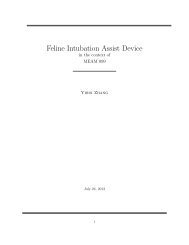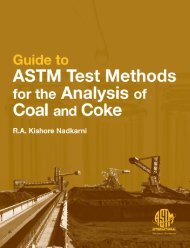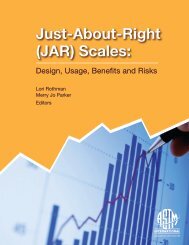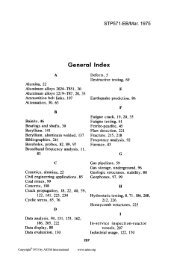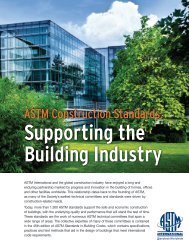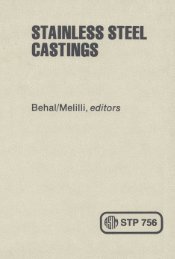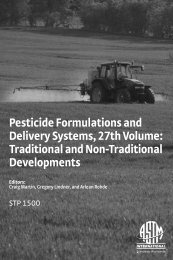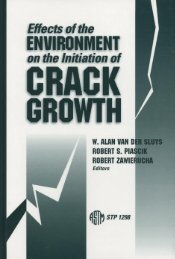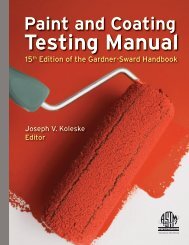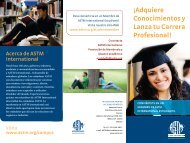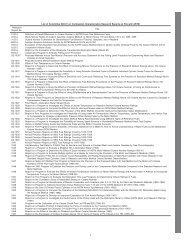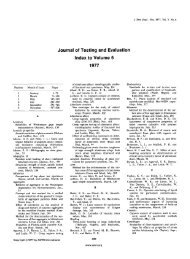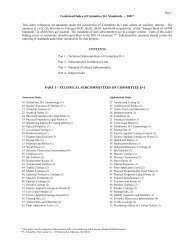Form and Style for ASTM Standards - ASTM International
Form and Style for ASTM Standards - ASTM International
Form and Style for ASTM Standards - ASTM International
You also want an ePaper? Increase the reach of your titles
YUMPU automatically turns print PDFs into web optimized ePapers that Google loves.
the other test methods should be designated as<br />
optional or nonreferee. When test methods are<br />
published separately, a worthwhile saving can be<br />
accomplished by making cross-references from<br />
one test method to another <strong>for</strong> the apparatus <strong>and</strong><br />
detailed description of the procedure.<br />
A2. Title (M<strong>and</strong>atory)<br />
A2.1 The title should be concise but complete<br />
enough to identify the nature of the test, the<br />
material to which is it applicable, <strong>and</strong> to distinguish<br />
it from other similar titles. Titles of analogous<br />
st<strong>and</strong>ards should be identical, except <strong>for</strong> the<br />
distinctive feature(s) of each st<strong>and</strong>ard. Titles are<br />
used frequently in lists, tables of contents,<br />
indexes, tabulating card systems, etc., <strong>and</strong> there<strong>for</strong>e<br />
should be brief but inclusive. Select words<br />
that easily lend themselves to indexing. The<br />
essential features of a title are the particular<br />
property or constituent being determined, the<br />
material to which the test method is applicable,<br />
<strong>and</strong> when pertinent, the technique or instrumentation.<br />
If the test method is designated to determine<br />
a number of constituents or properties, use a<br />
general title, omitting the names of specific constituents<br />
or properties. When a st<strong>and</strong>ard includes<br />
a number of individual test methods <strong>for</strong> different<br />
constituents or properties, the title need indicate<br />
only the general nature of the tests <strong>and</strong> the<br />
material to which it is applicable.<br />
A3. Designation <strong>and</strong> Year Date<br />
A3.1 Designation (m<strong>and</strong>atory)— The<br />
<strong>ASTM</strong> designation, assigned by Headquarters on<br />
submittal <strong>for</strong> approval, consists of the following<br />
sequential parts:<br />
A3.1.1 A letter designation denoting in general<br />
the classification according to material, product,<br />
system or service.<br />
A—Ferrous metals <strong>and</strong> products<br />
B—Nonferrous metals <strong>and</strong> products<br />
C—Cementitious, ceramic, concrete, <strong>and</strong> masonry materials<br />
D—Miscellaneous materials <strong>and</strong> products<br />
E—Miscellaneous subjects<br />
F—End-use materials <strong>and</strong> products<br />
G—Corrosion, deterioration, weathering, durability, <strong>and</strong><br />
degradation of materials <strong>and</strong> products<br />
FORM OF <strong>ASTM</strong> TEST METHODS<br />
A-3<br />
A3.1.2 A sequential number following the<br />
letter designation (<strong>for</strong> example, Specification<br />
C150).<br />
A3.2 Year Date: (<strong>for</strong> example, Specification<br />
C150-01).<br />
A3.2.1 After the designation, a hyphen is<br />
followed by the last two numbers of the year of<br />
acceptance or of last revision. If the st<strong>and</strong>ard is<br />
revised again during the same year, this is indicated<br />
by adding an “a” <strong>for</strong> the second revision,<br />
“b” <strong>for</strong> the third revision, etc.<br />
A3.2.2 The parenthetical phrase “(Reapproved<br />
20___)” to designate the year of last<br />
preapproval of a st<strong>and</strong>ard, if applicable.<br />
A3.2.3 For editorial changes that do not<br />
change the year designation, a note is inserted<br />
be<strong>for</strong>e the text to indicate the location <strong>and</strong> date of<br />
the change <strong>and</strong> a superscript epsilon ( e ) is added<br />
after the year designation. The epsilon designations<br />
<strong>and</strong> corresponding notes are numbered<br />
chronologically <strong>and</strong> are deleted upon occasion of<br />
the next revision or reapproval.<br />
A3.3 The designation numbers of st<strong>and</strong>ards<br />
that have been discontinued are not reassigned.<br />
A3.4 SI St<strong>and</strong>ards (see Part H <strong>and</strong> Section<br />
G24.)<br />
A4. Introduction<br />
A4.1 A separate section covering general<br />
introductory or in<strong>for</strong>mational material is not generally<br />
used in <strong>ASTM</strong> test methods. Occasionally,<br />
a test method is of such a nature that it requires an<br />
explanatory statement <strong>for</strong> proper underst<strong>and</strong>ing<br />
by the user. In such instances an introduction<br />
should be included immediately after the title of<br />
the test method but without a section number.<br />
A4.2 Examples of test methods that include<br />
introductions are as follows:<br />
D143 Test Methods <strong>for</strong> Small Clear Specimens of Timber<br />
D905 Test Method <strong>for</strong> Strength Properties of Adhesive<br />
Bonds in Shear by Compression Loading<br />
A5. Scope (M<strong>and</strong>atory)<br />
A5.1 Include in this section in<strong>for</strong>mation<br />
relating to the purpose of the test method. State if<br />
the method is quantitative or qualitative, <strong>and</strong> any<br />
known limitations. Concisely state the property<br />
or constituent that is being determined <strong>and</strong> the



